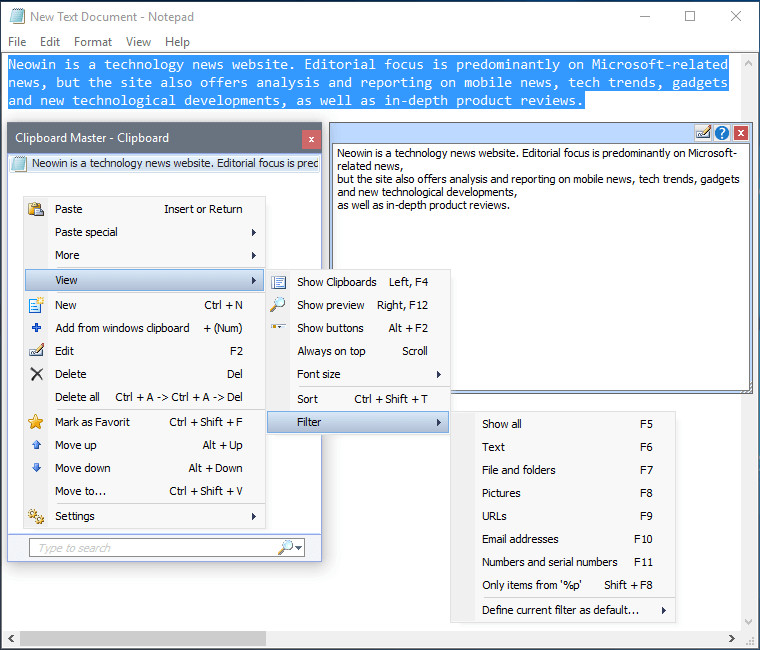

- Clipboard master install#
- Clipboard master full#
- Clipboard master portable#
- Clipboard master plus#
- Clipboard master free#
But on the flip side, it doesn’t have the best UI out there.
Clipboard master free#
The free version comes with screenshot capture and text expander option along with clipboard manager.
Clipboard master install#
Though that comes with a price tag of $15 per user.įinally, if you are someone who likes to install one app that does everything, that Clipboard master is a better choice. If you need a clipboard manager that sync between your Mac and Windows PC, 1Clipboard should work. If you are looking for freeware that just works, Ditto is a good option. We saw some of the best clipboard manager tools for Windows. Wrapping Up: Best Clipboard Manager for Windows In fairness to the other suggestion, you might want to read Clipboard Master vs Ditto: Comparing 2 Cool Windows Clipboard Managers and make your own choice.Īs good as it is, the user interface of Clipboard Master is not the best and as a result, there is a good amount of learning curve to get used to Clipboard Master.
Clipboard master portable#
Ditto also happens to be open-source and can be used as a portable application too. Uses sqlite database (and many more features.UTF-8 support for language files (create language files in any language).
Clipboard master full#
Clipboard master plus#
I have just tested this and it works.Įasy peasy, plus Ditto is the best clipboard manager that there is. Now, make all your selections to populate the clipboard, and finally, launch Ditto, hit Ctrl- A, then Ctrl- C, navigate to where you want to paste and hit Ctrl-v. I would recommend first clearing the clipboard – launch Ditto, hit Ctrl- A to select all, then hit the delete key, or right-click and select delete. It is gratis including for commercial porpoises. lossy-compressed web-compatible format and uncompressed web-incompatible format).Since this is such a basic, yet vital, utility, I have spent years looking for the ideal clipboard manager, and for me it is Ditto. Similarly, if a native application were to provide both web compatible and incompatible formats, it’s possible that the web application can only access a subset of information (ex. If a native application were to only provide web-incompatible formats, this would mean that no web application could interoperate with it. Existing APIs like setData would then not be capable of interacting with image/tiff, so this can limit in this example image editing applications (like or, who have asked for this sort of capability), as users would not be able to copy and paste this image format between these web and native applications. Therefore, in the image/tiff example, a native application like Photoshop or GIMP may choose to paste an image to the clipboard as image/tiff, which is not included in the Clipboard API spec. Native applications can essentially use any string to represent any format. This API is proposed to improve interoperability between web and native applications. The existing Async Clipboard API’s re-encoding is still encouraged for use cases requiring only generic types, and easier to use as custom encoders/decoders would not be necessary, but raw clipboard access allows web applications with more specific or sophisticated clipboard support needs to meet those needs. Web Apps supporting “niche” types, like LaTeX.Figma or Photopea, to copy/paste PhotoShop/GIMP, GIFs, or RAW images, or already-supported formats with not-supported metadata (long tail of metadata).Online editors like Google Docs or Microsoft Office 365, copy/paste OpenOffice or Microsoft Word documents/spreadsheets/presentations (proprietary formats).Raw Clipboard Access aims to provide a low-level API solution to this problem, by implementing copying and pasting of data with any arbitrary Clipboard type, without encoding and decoding. docx (a document format), are not supported by the current Web Platform. In particular, non-web-standard formats like TIFF (a large image format), and proprietary formats like. However, this API does not scale to the long tail of specialized formats. The existing Web Platform has a high-level API that supports the most popular standardized data types (text, image, rich text) across all platforms. Powerful web applications would like to exchange data with native applications via the OS clipboard (copy-paste).


 0 kommentar(er)
0 kommentar(er)
